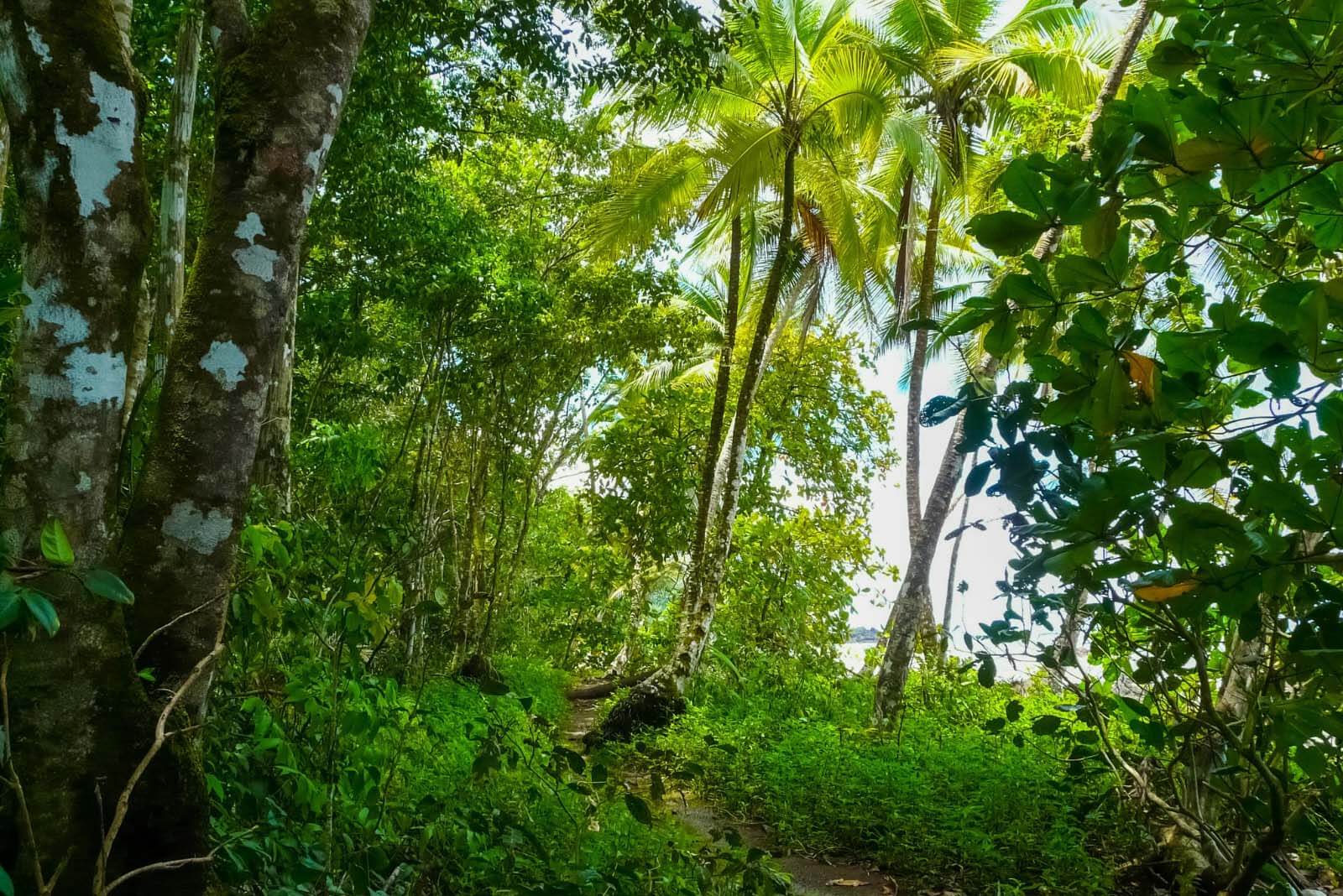Are you looking for an idea for your next vacation? If so, then you should definitely consider visiting Corcovado National Park. This national park is home to some of the most diverse ecosystems in the country and has a ton to do.
Why Visit Corcovado National Park?
 Corcovado National Park Beach
Corcovado National Park Beach
Before we get into why you should visit the Corcovado National Park, here’s some background about this national park. It was established in 1975 and is located on the Osa Peninsula in the Puntarenas Province. The park encompasses up to 430 km and is the largest park in Costa Rica. National Geographic has even named it the most biologically intense and diverse place not only in Central America but also on earth. Interestingly enough, the Osa Conservation Area, where Corcovado National Park resides, also protects the Ballena Marine National Park which is another park that is known for its biodiversity.
The park preserves the largest primary rainforest and secondary rainforests on the American Pacific coast. Unfortunately, tourism, which is the main source of income for Costa Rica, is threatening the park’s long-term existence and biodiversity by deteriorating its natural resources.
The park is home to several species of wild animals like mammals, birds, reptiles, amphibians, fish, insects, plants, and even trees. Some of them include the Baird Tapir, the rare harpy eagle, white-lipped peccaries, the American crocodile, the spectacled caiman, and some bull sharks. The park is also home to jaguars, ocelots, margay, jaguarundi, and even pumas. There are a few significant monkey species too, like the endangered Central America squirrel monkey, white-faced capuchin, howler monkey, and spider monkey. You can view the wildlife in their natural habitats.
Corcovado National Park encompasses 40% of the Osa Peninsula, home to one of Central America’s and the world’s richest biological communities. It is home to some 250,000 species and is known to be half of Costa Rica’s animal species in total. The peninsula is also known as the “Crown Jewel of Costa Rica,” because of its incredible biodiversity, spectacular scenery, and pristine beaches.
To be clear, not everyone enjoys visiting Corcovado. It’s one of the most remote natural reserves in Costa Rica. For tropical wildlife viewing and beach chilling, it’s one of nature’s most beautiful locations on Earth. If you’re into wildlife, hiking, nature, and stumbling upon beautiful sights, then this National Park would be a perfect trip for you.
Things To Do & Attractions in Corcovado National Park
 Corcovado National Park Forest
Corcovado National Park Forest
If you are looking for things to do in Corcovado National Park, then this article has got all the information you’ll need. This is one of the best places to see wildlife and nature. It is also famous for its beautiful beaches. There are many activities to enjoy in this region.
Take A Day Tour or Overnight Trip Through The Park
Are you short on time? This place is beautiful and a must-see if you enjoy unique nature and rare wildlife. Consider taking a day trip to this park.
You can choose from different day trips at each lodge in the national park. You could take an organized tour of Corcovado National park, including a plane ride to Sirena station, a guided hike through the park, and lunch. You can also explore it on foot on a challenging full-day walk which includes lunch. You could take a boat from here upriver to get to the park rangers’ station. Then you would continue on foot. To gain entry into Corcovado National park, you need to be accompanied by a professional guide.
See The Wildlife near the Sirena Ranger Station in the Park
The main attraction at Corcovado National park is the Sirena Ranger Station. Located in the heart of the country’s most pristine tropical rainforest, this remote outpost is one of the best places to see nature in Costa Rica. Visitors come to the park from different directions including by foot, by boat, and by airplane.
One of Costa Rica’s most popular experiences is sleeping overnight at Sirena. Even though they’re not stays, a day trip through the jungle leaves tourists amazed by the towering vegetation and the sheer number of animals. Many tourists consider visiting Sirena an important part of their vacation.
The ranger station is located several hundred yards away from the sandy beaches. There’s a small airstrip between the fields and the ocean where small planes land. There are seven hikes that lead away from the ranger station, winding through the primary forest between Río Claros and Río Sirenas.
If you decide to stay here for the night, Sirena has several wooden buildings including an office, dormitory-type rooms, bathrooms, and a restaurant. There are several paths connecting most of the buildings, protecting visitors from heavy rains.
Hiking in Corcovado National Park
 Crocodile in Creek, Corcovado National Park
Crocodile in Creek, Corcovado National Park
There are several trails and park entrances you can hike to explore this park. For example, if you want to enter a hiking entrance and make your way to the Sirena station, you can do so by entering through the La Leona Ranger Station (13.5 km hike), the Los Patos Ranger Station (20 km hike), or the San Pedrillo station. The San Pedrillo Station trail is well known for its unique plants and hundred-year-old trees, but not so much for the abundance of wildlife. There is also a decent chance of seeing a puma on this trail. There are a good amount of trails near the San Pedrillo and Sirena stations. You can usually only visit San Pedrillo if you’re traveling from Drake Bay. Puerto Jimenez, another entry point of the park, is a great starting point to start your travels into Corcovado National Park. Puerto Jimenez is not only a good starting point for one-day or multiday hikes, but it’s also one of the main entrances of Corcovado National Park. Some choose to travel to Corcovado National Park through Puerto Jimenez. It just depends on what direction you’re coming from, but the most common entry points are Puerto Jimenez and Drake Bay. Puerto Jimenez and Drake Bay are both on opposite sides of Corcovado National Park.
Another trail named Puma Valley, which starts at La Leona is a trail where puma sightings occur semi-regularly. The valley lies along a 16-kilometer (10-mile) trail and to reach the starting point, you must first pass through a tidal creek, which often has crocodiles in its water.
The El Tigre trail doesn’t start at a ranger station, but it begins with a steep 1-hour hike and then levels out into an up-and-down landscape. It takes between 7 and 8 hours for the entire 8km path once you’re officially on the trail. El Tigre is a region where there are no large animals, but it is teeming with insects, frogs, lizards, and other small creatures. It would be worthwhile to visit the park regardless of whether you’re there for the scenery or not.
Getting To Corcovado National Park By Boat, Car, Plane
 Corcovado National Park Beach
Corcovado National Park Beach
Whether you’re traveling straight from San José, or Manuel Antonio, there are multiple ways of getting to this park. Flying into San José’s International airport: Juan Santamaría International Airport is the best way to get to Corcovado National Park if you’re in that region. Domestic flights cost between $80-$100. If you’re interested in visiting the Sirena station, you could also consider hiring a private plane to take you there. If you’re near the Palmar Sur Airport in the Puntarenas Province, you may also consider flying from there and getting to the park through Sierpe. It is also possible to drive to Corcovado national park from San José, but it requires a lot of effort and some roads may be difficult to access. You need a solid four-wheeled vehicle for off-road driving, and you can rent a car in San José before you head over.
If you’re coming from Drake Bay, you’ll probably arrive at Corcovado National Park by either entering through San Pedrillo or via Sirena Station. Both of these locations are on the north coast of the Osa Peninsula, near Drake Bay. You might get soaked when you arrive at either station. San Pedrillo is one of the northernmost rangers stations in the national parks and takes about 25 minutes to reach by boat. Sirena station is located approximately an hour away from Drake Bay by water. The Sirena ranger’s office is also the headquarters for the park. Surrounded by lush forests, wildlife can often be spotted from the network of hiking paths accessible from the Sirena Station. Only the Sirena Rangers’ Station offers a dining hall where you can buy food.
There aren’t any roads within the park. After entering through the main gate, you can only explore the grounds on foot. The general entrance fees into the park are $18. If you’re taking a boat from Puerto Jimenez to the Sirena Ranger station and then back, that trip costs $60. If you plan to stay overnight at the dormitory-style rooms of the Sirena station, that costs $30 a night. Last but not least, meals in the Sirena Ranger station cost from $12 – $30 depending on the time of day and the meal type. You can’t enter the park without a certified guide.
Best Time To Go To Corcovado National Park & What To Bring
When it comes to visiting Corcovado National Park during the dry season, the park tends to be the busiest during the driest months of December to April. It’s rumored that the driest time of year to go to the park is in March. Rainy seasons begin in May and last until early December. Rainy weather tends to be heavy during the months of September and October. In fact, during the month of October, it’s common for some lodges on the Osa Peninsula to temporarily close due to the very heavy rainfall. The weather in Costa Rica when it comes to dry season and rainy season is pretty consistent.
High humidity and high temperatures can also be intense. It rains an average of about 20 inches per year at Corcovado National park. Dress appropriately and bring proper gear for your stay here! It’s best not to hike in the park when it rains because it gets really muddy. It can be hard to walk along the beach if it’s high tide. As far as what to bring with you, you may consider investing in some hiking shoes, sandals, and water shoes if you haven’t already. You’ll also want to bring some hydration tablets, a refillable water bottle, plenty of water, a hat, a bathing suit, waterproof clothing (especially a waterproof jacket), bug spray, sunscreen, and a bag to store things in while you’re exploring the park.








